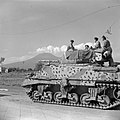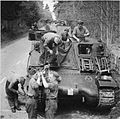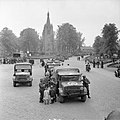Discussion:Signalétique des unités britanniques pendant la Seconde Guerre mondiale/Bac à sable
- Admissibilité
- Neutralité
- Droit d'auteur
- Article de qualité
- Bon article
- Lumière sur
- À faire
- Archives
- Commons
Pendant la Seconde Guerre mondiale, l'armée britannique a développé un système très élaboré et haut en couleurs, d'un abord parfois abscons, de markings (signalétique d'identification) pour les véhicules de ses divisions, brigades, unités et services parallèlement à leur immatriculation via le WD Number ou aux logos techniques tels que les Bridge classifications. Pour compliquer encore les choses, certaines unités développèrent leur propre système de markings « librement » (sic) inspirés des règles établies. Leur positionnement sur les véhicules, bien que codifié, a donné lieu lui aussi à quelques libertés.
Formation signs were first used by the British Army in WW1 in order to provide an easy method of visual identification of the various units. They were worn on the upper sleeve in pairs, on epaulets, on head gear, painted on unit vehicles, and used on road signs. It was also quickly found that the signs created a morale boosting esprit de corps as each unit became proud of its own symbol. After WW1 the use of formation signs was discontinued, they were reintroduced at the outbreak of WW2.
La mécanisation de l'armée britannique dans l'entre-deux-guerre
modifierThe British Army invented the tank and pioneered its development during World War I, and produced the leading theorists of Armored warfare, J.F.C. Fuller and B.H. Liddell Hart, during the interwar years.
British armored forces were improperly trained for the type of combat which confronted them in World War II, primarily because « the British Army refused to change its basic strategic doctrines to maximize the potential of a new weapon of war » [1]. In the Interwar years, the ratio of armor to Infantry decreased – when it should have logically been increased. Pre-World War I military strategy was based upon the Napoleonic experience of “absolute war” and of the destruction of the opponent’s forces through unrelenting offensive pressure, the application of maximum force in the decisive attack, and “an unswerving determination by both commanders and troops to conquer at any cost.” The victory of Britain and her Allies in the Great War – a war of attrition – vindicated in the minds of the generals their faith in this conception of war, confirming their dependence upon a psychological distortion of Clausewitz. It was this dogmatic rigidity to the army’s traditional strategic doctrine, according to Robert H. Larson, which fettered innovations in British military thought during the interwar period [2].
-
Chenillette Carden-Loyd Mk VI Mortar Carrier tractant un 3.7 inch QF Howitzer Mk I monté sur remorque spéciale, avec plaque d'immatriculation civile.
-
Char léger Vickers-Armstrong Mk VIA du 3rd King's Own Hussars. en 1937. Il ne présente lui aussi que la plaque d'immatriculation civile pour seul marquage.
La British Expeditionary Force en France en 1940, la Home Defense et la reconstruction de l'armée
modifier-
Char d'infanterie Matilda I en France pendant l'hiver 1939-40
-
Chars Covenanter de la Guards Armoured Division pendant sa phase de constitution en Angleterre
Livrées et camouflage
modifierLes markings
modifierIn 1942 Royal Amoured Corps H.Q. standardised the size, colour and location of insignia to be worn on vehicles of British and Commonwealth tank units.
The vehicle numbering system made huge sense for traffic control in the UK and North West Europe. It helped to sort out one convoy from another.
Markings techniques
modifierIdentification
modifierOriginally white/red/white, the sign of the Tank Corps in World War One, with the formation of the Royal Armoured Corps the colours were reversed.
Markings d'unité et de service
modifier-
Le WD Number sur le réservoir d'une moto BSA.
-
Insigne du 21e Groupe d’armées britannique.
-
Insigne du XXXth Corps
-
6th Armoured Division
Les blindés
modifier- Squadron Recognition .
Geometric shapes coloured as per unit seniority: Red - Yellow - Blue : Triangle : A Squadron - Carré : B Squadron - Cercle : C Squadron - Losange : Regimental Headquarter and Recce Squadrons
- Troop Recognition
Inside the geometric shape, in white, is the Troop number, and for HQ Fighting Troop the letter F. The background colour is that of the turret. They are positioned in the centre of the left and right sides of the turret.
-
Logos identifiant les Squadrons au sein d'une unité blindée.
-
Sherman Mk V de la Guards Armoured Division
-
Idem
La 79th Armoured Division
modifier-
79th Armoured Division.
L'infanterie
modifierL'artillerie
modifierLes unités de reconnaissance
modifierAutres services et unités indépendantes
modifierRoyal Air Force et Royal Navy
modifierAfrique du Nord, Moyen-Orient et Italie
modifierThere was not the same pressure to put tactical markings on vehicles is North Africa. A lot of things were improvised and organisation changed either through lack of equipment and/or quickly changing circumstances. Everything used by the fighting troops had to be delivered along a long supply chain and pots of paint were low priority. In battle tanks were knocked out quickly.
-
Cocarde de la Royal Air Force.
Europe 1944-45
modifierPendant la campagne d'Europe, l'armée britannique adopta l'étoile blanche américaine comme signe d'identification visuelle rapide.
-
Churchill CS de la 6th Guards Tank Brigade préservé en Hollande
Le front asiatique
modifierUnités polonaises et belges libres et troupes du Commonwealth
modifieren:2nd Armoured Brigade (Poland)
-
6th South-african Armoured Division
-
1st South-africn Division
Surnoms, graffitis et marquages temporaires
modifierArticle connexe
modifierBibliographie
modifier- (en) Terence Wise & John Major : World War Two Military Vehicle Markings, Patrick Stephens Limited Publications, 1981 (ISBN 9780850594393).
- (en) Peter Hodges & Michael D Taylor : British Military Markings 1939-1945 , Cannon Publications, 1994.
- (en) Robert H. Larson : The British Army and the Theory of Armored Warfare, 1918-1940, University of Delaware Press, Newark 1984.
Liens externes
modifier- (en) British formation badges 1939-1945
- (en) Markings on military vehicles
- (en) British Armour Markings of the Second World War 1939 to 1945
- (en) BEF markings in France 1939-1940 - Part I & Part II
- (en) Cruisers in the UK
- (en)The Desert War - Part I & Part II
- (en) British, Commonwealth and Polish tank formations in Italy 1944 and their Markings
- (en) British 21st Army Group markings
- (en) British Tank Markings in Normandy
- (en) World War II Canadian army Provost units markings
Notes et références
modifierNotes
modifierRéférences
modifier- Robert H. Larson : The British Army and the Theory of Armored Warfare, 1918-1940 : présentation et synthèse.
- Idem
Catégorie:Unité militaire de la Seconde Guerre mondiale Catégorie:Histoire militaire du Royaume-Uni









































































